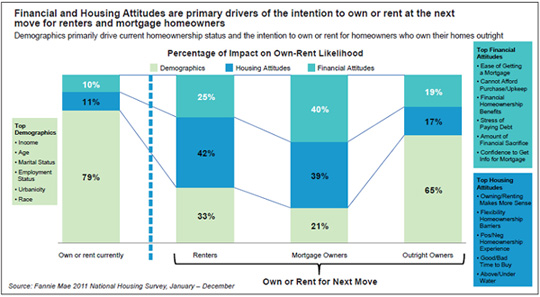What Drives Consumers' Intentions to Own or Rent?

Over the past few years, Americans have experienced the most significant housing crisis since the Great Depression. The crisis has raised important questions about the demand for homeownership and has prompted us to investigate what influences Americans’ intentions to own or rent their home. Examining the drivers of Americans’ homeownership preferences has important implications for housing industry players. Our study provides insights for better managing housing-related risks and for encouraging consumers to make sustainable housing choices to ensure a well-functioning housing marketplace.
To perform this study, we used all the 12 months of 2011 data from the Fannie Mae’s National Housing Survey. Based on these data, we conducted predictive modeling to investigate which (subjective) attitudes and (objective) demographics best accounted for individuals’ current status as homeowners or renters as well as their intentions to own or rent if they were to move.
In particular, with regards to consumers’ next-move own-rent intentions, we built separate models for three different population groups, as we believe that they generally represent different life stages with respect to housing tenure:
- Current renters
- Current homeowners with a mortgage (mortgage-owners)
- Current homeowners without a mortgage (outright-owners)
The modeling results shown in the figure below groups the top predicting variables into three categories: Demographics, Housing Attitudes, and Financial Attitudes. Our models show:
- Demographics (such as income, age, marital status, and employment status), by a wide margin over financial and housing attitudes, are the primary drivers of current homeownership status and the intention to own or rent for outright-owners.
- However, in relation to one’s next-move housing preference, housing attitudes (such as the belief that owning or renting makes more sense financially) and financial attitudes (such as the perceived ease/difficulty of getting a mortgage) are the key drivers of the intention to own or rent for renters and mortgage-owners.

We also found that exposure to default, perceived home value appreciation/depreciation, and self-reported underwater status make minimal incremental contributions to predicting the own-rent intention in the models.
The above key findings suggest that:
- Americans are affected by a mix of demographic and attitudinal drivers in making the own-rent decision. It is possible that many of these drivers, especially the attitudinal ones, act as automatic or unconscious biases that lead consumers to less fulfilling and successful housing choices – e.g., needs that drive a consumer to over consume in their home purchase and ultimately default, or fears that prevent a well-qualified renter from purchasing a home that will better suit their needs. Resources to help consumers to more deliberately understand and balance these drivers may allow them to make better, more sustainable housing choices.
- Exposure to mortgage default, perceived home value appreciation/depreciation, and self-reported underwater status are not significant factors in the models in predicting individuals’ intentions to own a home for their next move. These results suggest that Americans’ aspirations to own a home are strong even facing the dramatic challenges in the housing market over the past few years.
For more information, please visit the Own-Rent Analysis page within the Research & Analysis section on the Fannie Mae web site.
Li-Ning Huang and Steve Deggendorf
Economic & Strategic Research
August 2, 2012
The views expressed in these articles reflect the personal views of the authors, and do not necessarily reflect the views or policies of any other person, including Fannie Mae or its Conservator. Any figures or estimates included in an article are solely the responsibility of the author.
